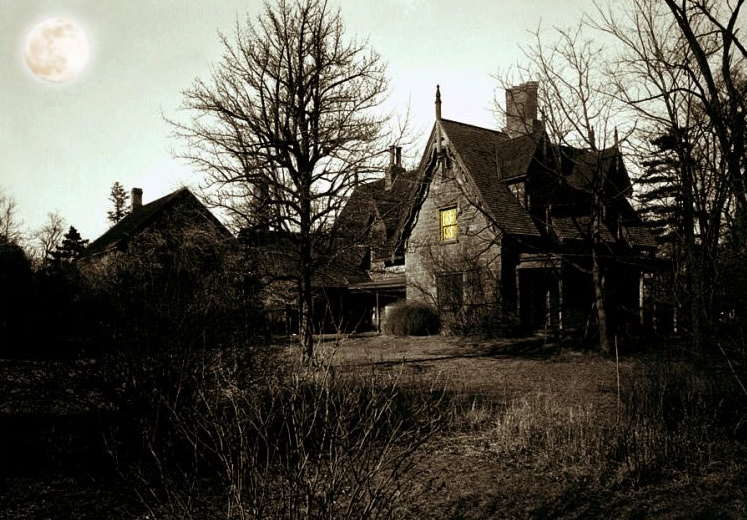
The Rosencrantz family is long dead, but being dead doesn’t stop them from entertaining guests at the historic Hermitage in Ho-Ho-Kus. The ghosts of the Hermitage do not wander the old mansion alone. They have plenty of (living) company as their old home is also a museum.
Set back from a busy main road in North Jersey’s affluent town of Ho-Ho-Kus sits a lone sentinel of the area’s past called the Hermitage. A house stood at the location of the present-day Hermitage as early as 1740. In 1763, a new stone house was built on the property. No drawings or other images of those houses exist; though part of the 1763 structure is incorporated into the present Hermitage.
 The old homestead is perched on the last remaining couple acres of a once vast estate that played host to a list of dignitaries during the Revolutionary War which included George Washington, James Monroe, the Marquis de Lafayette, Alexander Hamilton and Aaron Burr. In 1782, the Hermitage’s then owner Theodosia Prevost married Burr after her husband died while serving with the British army. The house went through changes of ownership for several years before the Rosencrantz family moved in—to stay.
The old homestead is perched on the last remaining couple acres of a once vast estate that played host to a list of dignitaries during the Revolutionary War which included George Washington, James Monroe, the Marquis de Lafayette, Alexander Hamilton and Aaron Burr. In 1782, the Hermitage’s then owner Theodosia Prevost married Burr after her husband died while serving with the British army. The house went through changes of ownership for several years before the Rosencrantz family moved in—to stay.
It’s not Aaron Burr or any of his Revolutionary pals who haunt the Hermitage. Burr and Theodosia married and left the Hermitage, moving to Albany. The Rosencrantz family is a different story. In 1807, Elijah Rosegrant (Rosencrantz) and his wife, Cornelia Suffern purchased the large property and settled in for the long haul. Four generations of family have called the Hermitage home.
The last surviving family member, Mary Elizabeth Rosencrantz, died in 1970 and, like some of her ancestors, has yet to leave the home. Whether you stand inside or outside the house, the energy is palpable. If you are are sensitive to things of a ghostly nature you may even feel as though you are being watched. You most likely are.
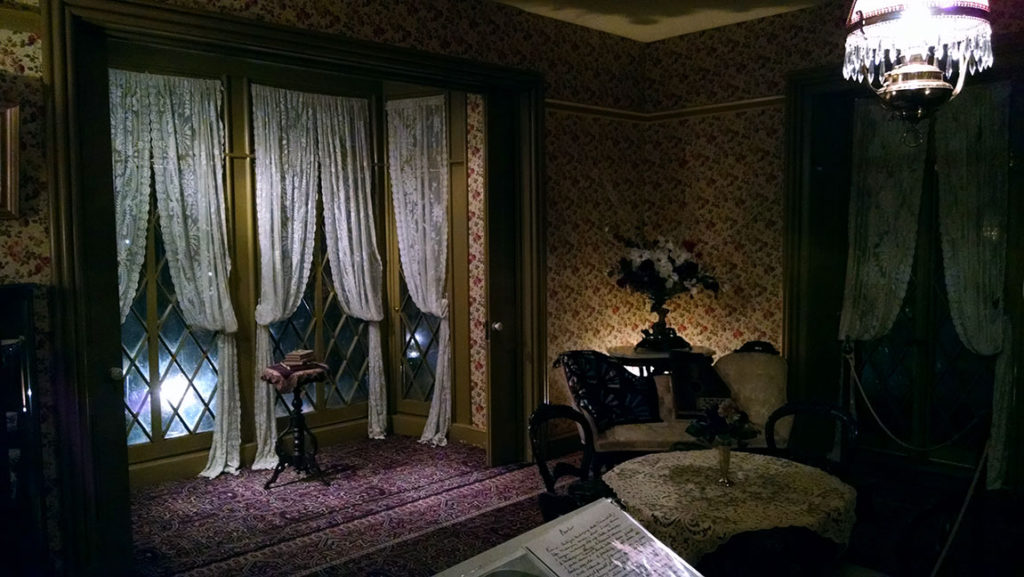
This historic estate has been faithfully maintained since 1972 by a historic preservation group called the Friends of the Hermitage. My first experience here was quite random. The Friends of the Hermitage offer house tours throughout the year, I had seen the sign many times, but never gave it a second thought. Finally one day, a friend and I stopped in for a visit. I was delighted to find a magnificent treasure-of-a-home behind the thick gingerbread-colored stone exterior! My visit was more out of curiosity that day as I had driven by this house many, many times and never thought to give it a closer inspection. Growing up on the other side of Bergen County, I had never heard of the ghostly legends associated with this house that many locals knew well. One pass through the first and second floors and I became quickly acquainted with a few others following the tour, who just happened to be dead.
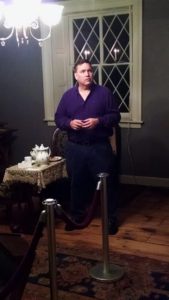
When I mentioned to the docent, who must not have been on the job very long, that I sensed two female presences that were like sisters in the old parlor (pictured above,) she was delighted to listen, but also quietly warned me that her superiors did not want any talk of ghosts in the house. This is something I come across quite often. It is understandable that some historic sites do not feel comfortable talking about ghosts and hauntings for personal reasons. However, historical sites also need tourists coming to visit and I can tell you from experience, there are lots of tourists who love a good ghost story. People managing tours just need to know their audience. If someone is uncomfortable with the topic, then don’t discuss it on that tour. If people ask, and they are truly interested, by all means, give up the ghost! I find the idea of some people trying to hide their ghosts really amusing. One cannot hide a ghost from people who are sensitive or if that ghost wants to be known.
Luckily many historical museums and sites now realize that ghosts bring in business. This is not to say I am recommending creating a ghost or ghosts that are not there, but if you do have a real ghost and a history of ghostly activity you think might interest your visitors, why not add it into the program? Since I first visited, the group that managed the Hermitage has changed their stance on the idea of spirits in the house. They are much more open to the idea, and people love them for it—as evidenced by a week of sold out ghost events each Halloween week.
You can read all about the history of the Hermitage and join the Friends of the Hermitage as a member here.
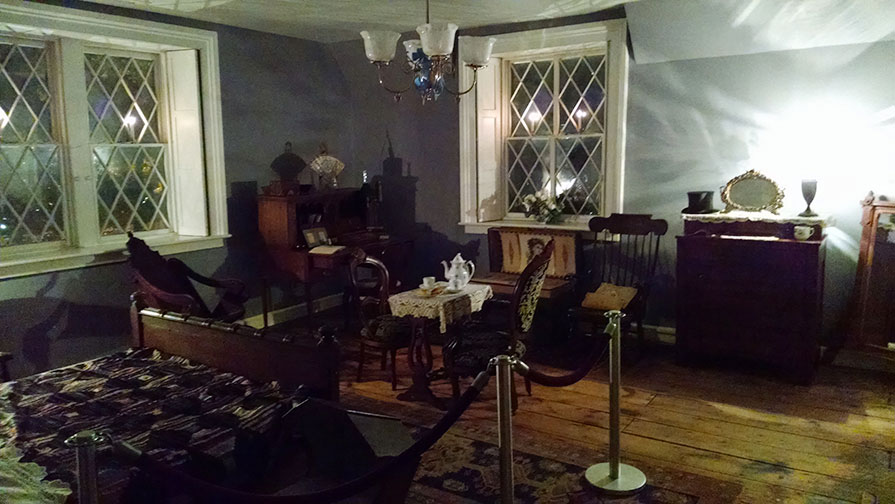
Now let’s talk about the cast of ghostly characters here. Whether it’s the heavy energy or perfume smells associated with the master bedroom (above) or physical manifestations like objects moving or phantom footsteps in the attic, the Hermitage usually never fails to entertain on the paranormal stage. The first is the last surviving member of the house Mary Elizabeth Rosencrantz. Mary Elizabeth was the fourth generation of the family to live in the house. After her Aunt Bess died in 1943, she found herself alone in the old house with dwindling resources. She invited Kathryn “Katie” Zahner, her late Aunt Vinnie’s maid, to come and live with her. Katie’s employer had died and she was destitute. Mary Elizabeth needed company and the two clicked.

The two women lived together in the house for the next 25 years. Eventually the companions ran out of money, but Mary Elizabeth was determined to keep the house and its history preserved. In 1961, she wrote a will in which she stated: ” I give & bequeath to the State of New Jersey the Historic Hermitage & all its furnishings & land upon which it stands . . . to be used as a museum & park.” She and Katie scraped by for years to keep the house standing, even though family members and friends urged them to sell.
The Rosencrantz history ended (well, it never really ended) when in early 1970, Mary Elizabeth badly burned herself on the old fireplace coal stove they were cooking meals on in a back room. She and Katie lived in a few of the rooms in the old house in the winter, as they could not afford to heat it. Electricity was finally reinstalled in the late 1960s! After her accident, Mary Elizabeth went to the hospital and, during the recovery process in the nursing home, contracted an infection unrelated to her visit which eventually killed her. She died in March 1970.
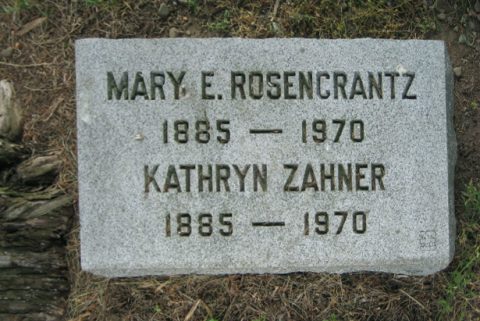 Katie Zahner, left alone in the old house, was invited to stay at the home of a friend, where she died five days later. The two were inseparable in life and, I believe, in death as well. They are buried together in Valleau Cemetery in Ridgewood, NJ in the same grave (right.) The energy of “two sisters” that I felt in the house on my first visit was most likely Mary Elizabeth and Katie.
Katie Zahner, left alone in the old house, was invited to stay at the home of a friend, where she died five days later. The two were inseparable in life and, I believe, in death as well. They are buried together in Valleau Cemetery in Ridgewood, NJ in the same grave (right.) The energy of “two sisters” that I felt in the house on my first visit was most likely Mary Elizabeth and Katie.
Three of the other main players in the spirit world at the Hermitage are: Elijah Rosencrantz the 2nd, who had major renovations done to the house in 1847 creating the house we see today; Elijah’s wife Cornelia (Killie) Livingston Dayton and their daughter Mary Elizabeth “Bess” Rosencrantz. Bess also loved history and opened the tea room in 1917, entertaining patrons about the home’s history and its ghosts. She loved ghost stories and it’s quite ironic that she is now one of them herself.
No matter where I move around the old Hermitage I seem to be followed by one ghost or another. Some of the hot spots seem to be Elijah’s office adjacent to the dining room which reveals a strong presence of its former owner, and the master bedroom where I have sensed both Elijah and Killie, his young first wife who died in 1867. The master bedroom was part of the renovation Elijah had done to attract a new bride, which turned out to be Killie. Since it was her bedroom first, the others in the house in spirit seem to respect her space. Down the hall, in Aunt Bess’ bedroom, tour groups have experienced cold spots and when asked for a sign, Aunt Bess has obliged by turning off the light above on two instances.
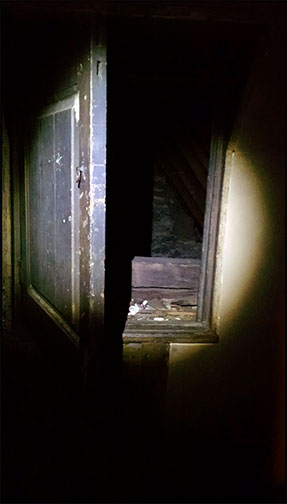
One of the more nerve-rattling places in the house is down an old, less traveled hallway in the back of the house where the bathroom and sewing room were once, and the secret (once sealed up) room behind the trap door (left.) Many years ago, Will Rosencrantz (Bess’ brother) apparently discovered (by breaking through a plaster wall) a secret room in the eve of the side extension. This hidden room was probably just walled off because the entrance way was so small, but opening that old door made me feel like I had opened someone’s tomb. As I opened the trap door and peered inside to the dark, clammy vast room, I felt a rush of cold air blow passed me. On my audio recording, EVPs appeared only after I opened the door, not anytime before. Two men could be heard speaking in garbled voices. I closed the door and the audio fell silent.
When the Friends of the Hermitage first took over the house in 1972, major renovations were in order. The house had seen 50 years of neglect and needed a major overhaul. During the first months of the house being reopened to the public, docents reported hearing phantom singing and piano music. The original piano had been shipped off to Ringwood Manor at the time, so nothing was present that anyone (living or dead) could have played to create the music.
I interviewed a few people who said that after the companions died, they would hear a woman’s voice shouting from the upstairs windows. The house had a reputation for being haunted for many years, and after Mary Elizabeth and Katie passed, the ghostly cast expanded.
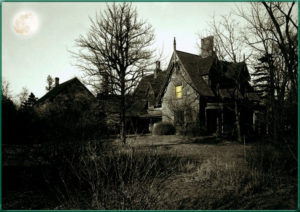
Today I am sure the family is delighted that the house is alive and well, both physically and spiritually. I have started an annual Halloween week program of ghost tours and investigations that runs during the last week of October. In 2017, I hosted two events called a Psychic Tea or “tea with the ghosts,” to commemorate the centennial of the first tea room opening in 1917. The only difference is, the first hosts are now the ghosts.
The Hermitage also offers regular house tours and events throughout the year. If you go, you may or may not experience some paranormal activity. Ghosts are funny that way. A house is only haunted if the ghosts are at home. The Rosencrantz family seems sometimes to be busy, but if you are lucky, one of them will be swirling around to greet you. If you love history, and a good haunt, the Hermitage should be on your (kick the) bucket list.
